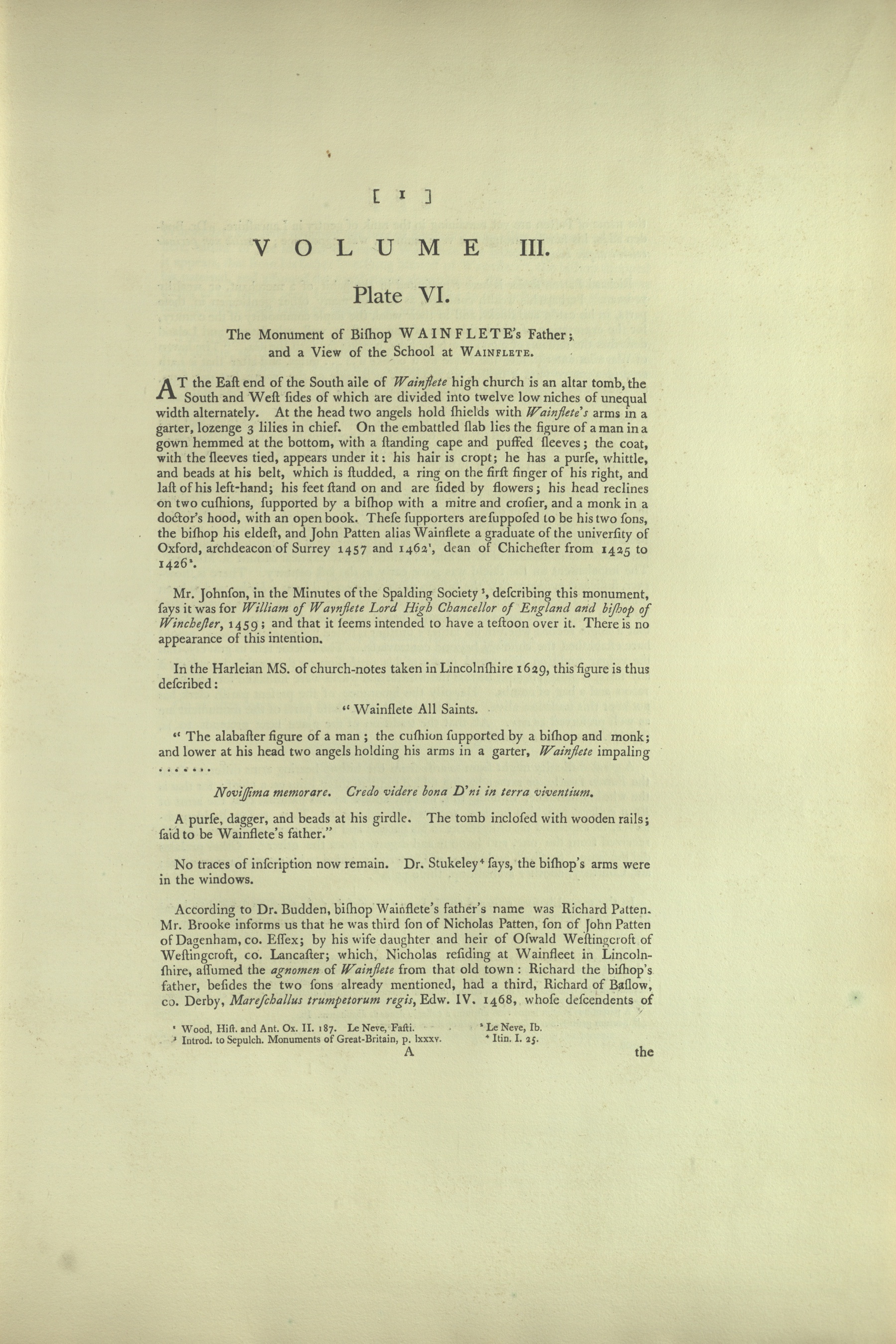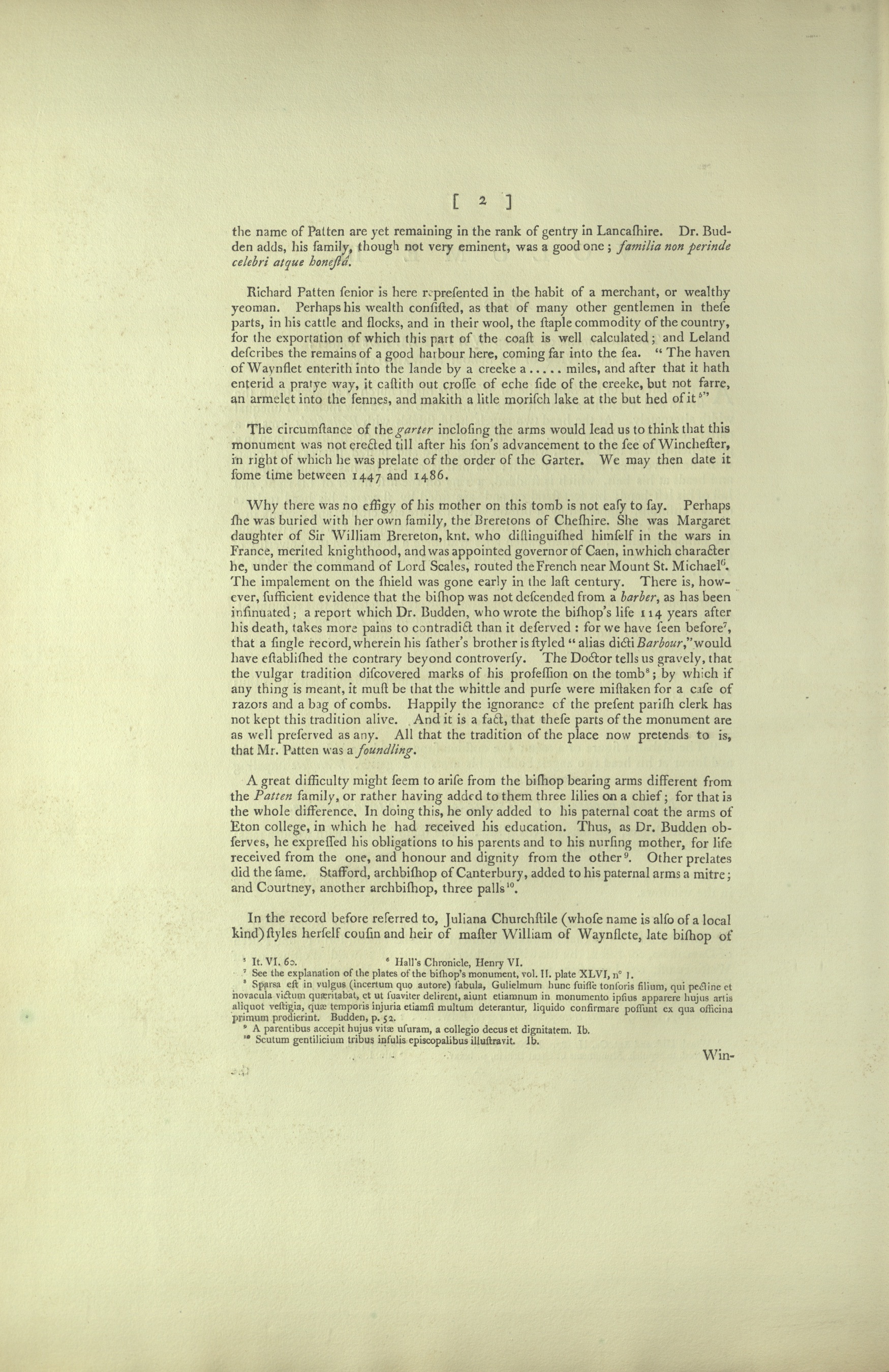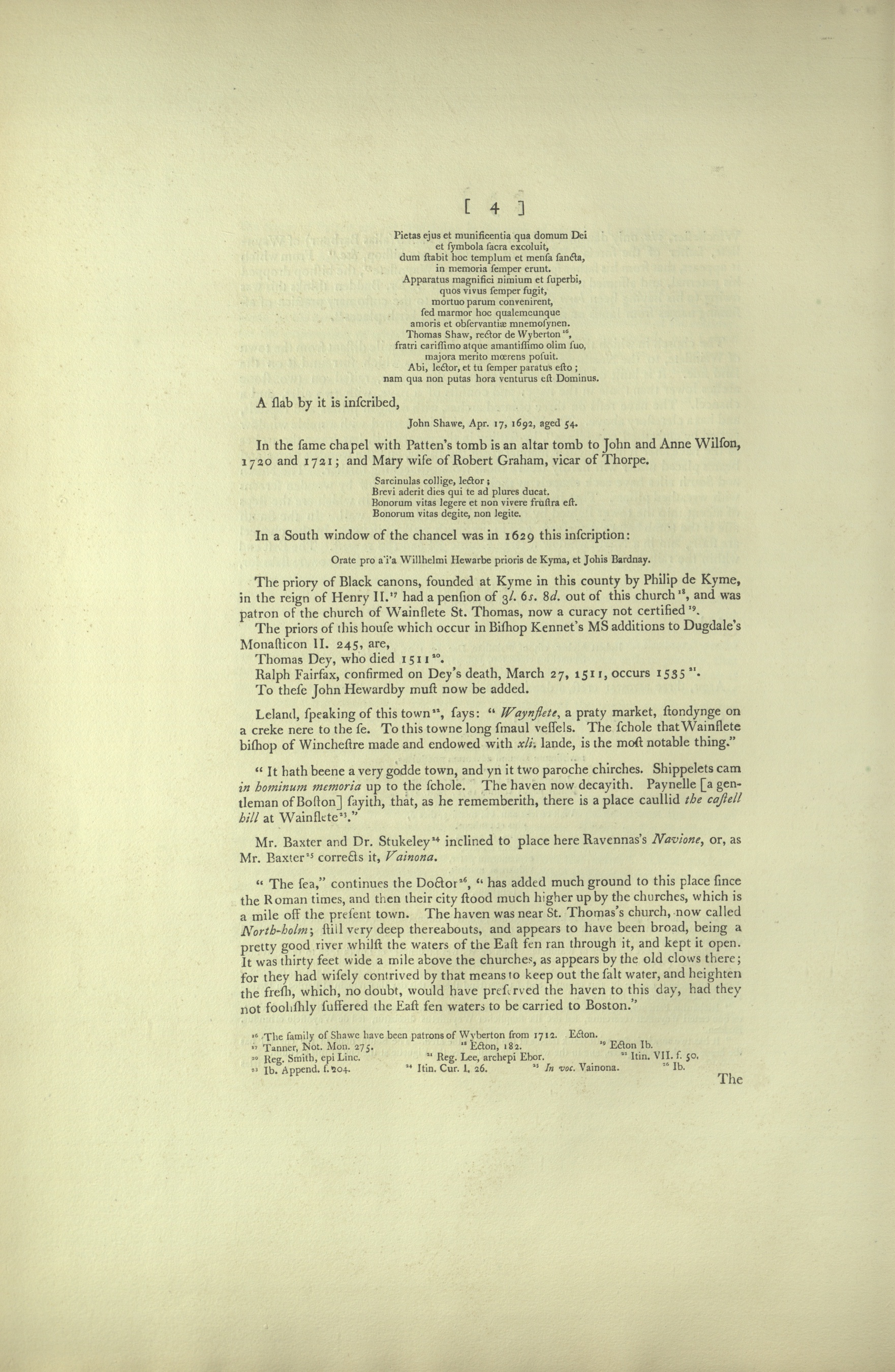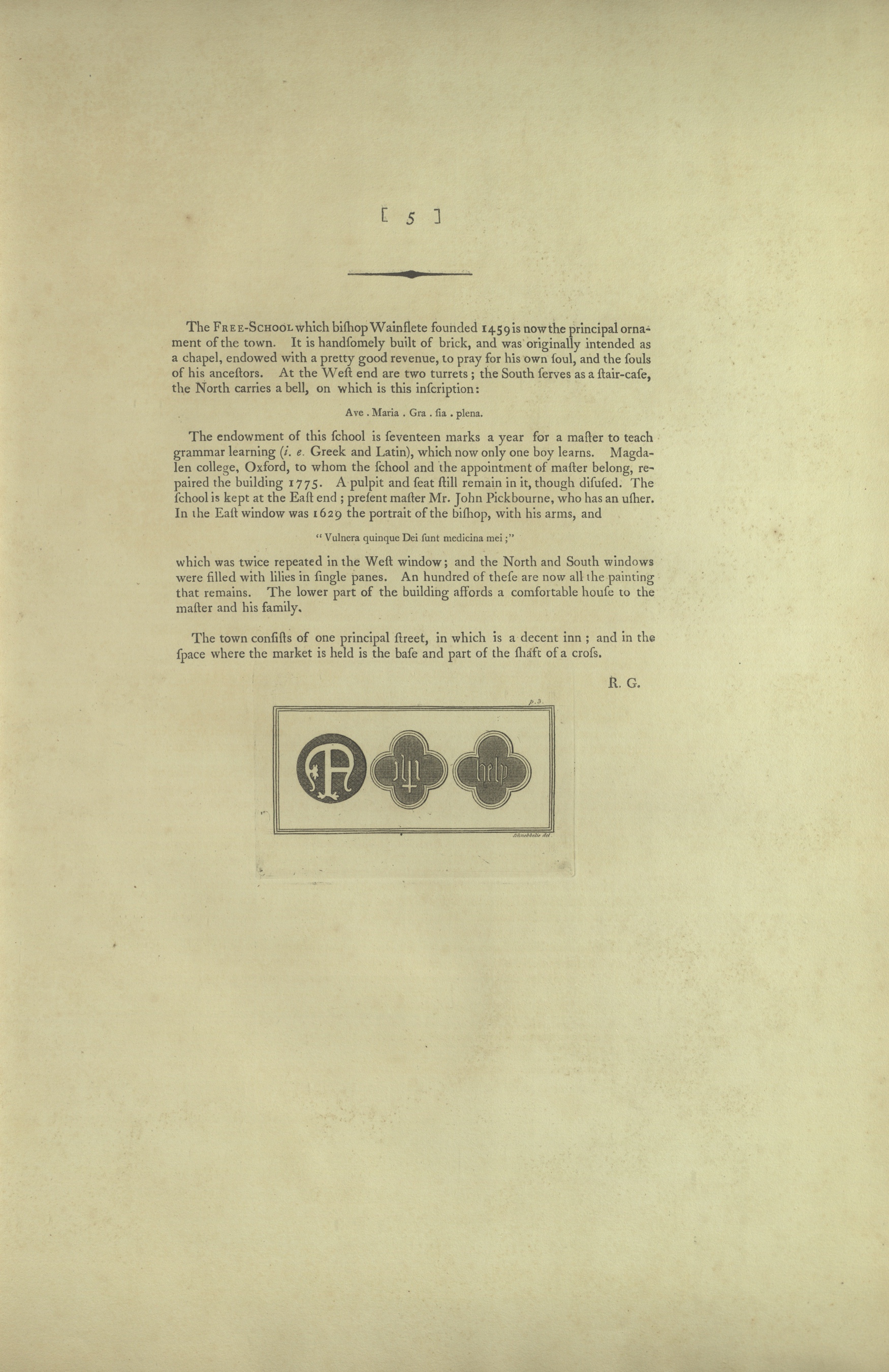
Creative Commons Attribution-Noncommercial-No Derivative Works 3.0
Plate 3.6: Waynflete School and Richard Patten Monument (Original Explanatory Account)
1 media/vm1-02-cropped.jpg 2020-08-02T06:41:40+00:00 Quanah Leija-Elias fc578bb41a53b12f2a08253bc8cc52547b2ff8bb 31 97 Original Explanatory Account for Vetusta Monumenta, Plate 3.6. plain 2024-06-26T19:05:17+00:00 Noah Heringman ed5eca6418903b1281787a0c30645d943ca84184
[(Page) 1]
VOLUME III. PLATE VI. The Monument of Bishop WAINFLETE’S Father; and a view of the School at Wainflete.
AT the East end of the South aile of Wainflete high church is an altar tomb, the South and West sides of which are divided into twelve low niches of unequal width alternately. At the head two angels hold shields with Wainflete’s arms in a garter, lozenge 3 lilies in chief. On the embattled slab lies the figure of a man in a gown hemmed at the bottom, with a standing cape and puffed sleeves; the coat, with the sleeves tied, appears under I : his hair is cropt; he has a purse, whittle, and beads at his belt, which is studded, a ring on the first finger of his right, and last of his left-hand; his feet stand on and are sided by flowers; his head reclines on two cushions, supported by a bishop with a mitre and crosier, and a monk in a doctor’s hood, with an open book. These supporters are supposed to be his two sons, the bishop his eldest, and John Pattern alias Wainflete a graduate of the university of Oxford, archdeacon of Surrey 1457 and 14621, dean of Chichester from 1425 to 14262.
Mr Johnson, in the Minutes of Spalding Society3, describing the monument, says it was for William of Waynflete Lord High Chancellor of England and bishop of Winchester, 1459; and that it seems intended to have a festoon over it. There is no appearance of this intention.
In the Harleian MS. of church-notes taken in Lincolnshire 1629, this figure is thus described:
“Wainflete All Saints.
“The alabaster figure of a man; the cushion supported by a bishop and monk; and lower at his head two angels holding his arms in a garter, Wainflete impaling…….
Novissima memorare. Credo videre bona D’ni in terra viventium. [Remember the last. I believe I see the good things of the Lord in the land of the living.]
A purse, dagger and beads at his girdle. The tomb inclosed with wooden rails; said to be Wainflete’s father.”
No traces of inscription now remain. Dr. Stukeley4 says, the bishop’s arms were in the windows.
According to Dr. Budden, bishop Wainflete’s father’s name was Richard Patten. Mr. Brooke informs us that he was third son of Nicholas Patten, son of John Patten of Dagenham, co. Essex; by his wife daughter and heir of Oswald Westingcroft of Westingcroft, co. Lancaster; which, Nicholas residing at Wainfleet in Lincoln-shire, assumed the agnomen of Waninflete from that old town: Richard the bishop’s father, besides the two sons already mentioned, had a third, Richard of Baslow, co. Derby, Mareschallus trumpetorum regis, Edw. IV. 1468, whose descendents of
1Wood, Hist, and Ant. Ox. II. 187. Le Neve, Fasti. 2Le Neve, Ib.
3Introd. to Sepulch. Monuments of Great-Britain, p. lxxxy. 4Itin. I. 25.

[(Page) 2]
the name of Patten are yet remaining in the rank of gentry in Lancashire. Dr. Budden adds, his family, though not very eminent, was a good one; familia non perinde celebri atque honesta.
Richard Patten senior is here represented in the habit of a merchant, or wealthy yeoman. Perhaps his wealth consisted, as that of many other gentlemen in these parts, in his cattle and flocks, and in their wool, the staple commodity of the country, for the exportation of which this part of the coast is well calculated; and Leland describes the remains of a good harbor here, coming far into the sea. “The haven of Waynflet enterith into the lande by a creeke a….. miles, and after that it hath enterid a pratye way, it castith out crosse of eche side of the creek, but not farre, an armlet into the fennes, and makith a little morisch lake at the but hed of it5”
The circumstance of the garter inclosing the arms would lead us to think that this monument was not erected till after his son’s advancement to the see of Winchester, in right of which he was prelate of the order of the Garter. We may then date it some time between 1447 and 1486.
Why there was no effigy of his mother on this tomb is not easy to say. Perhaps she was buried with her own family, the Breretons of Cheshire. She was Margaret daughter of Sir William Brereton, knt. Who distinguished himself in the wars in France, merited knighthood, and was appointed governor of Caen, in which character he, under the command of Lord Scales, routed the French near Mount St. Michael6. The impalement on the shield was gone early in the last century. There is, however, sufficient evidence that the bishop was not descended from a barber, as has been insinuated; a report which Dr. Budden, who wrote the bishop’s life 114 years after his death, takes more pains to contradict that it deserved: for we have seen before7, that a single record, wherein his father’s brother is styled “alias Dicti Barbour” [otherwise known as Barbour], would have established the contrary beyond controversy. The Doctor tells us gravely, that the vulgar tradition discovered marks of his profession on the tomb8 ; by which if any thing is meant, it must be that the whittle and purse were mistaken for a case of razors and a bag of combs. Happily the ignorance of the present parish clerk has not kept this tradition alive. And it is a fact, that these parts of the monument are as well preserved as any. All that the tradition of the place now pretends to is, that Mr. Patten was a foundling.
A great difficulty might seem to arise from the bishop bearing arms different from the Patten family, or rather having added to them three lilies on a chief; for that is the whole difference. In doing this, he only added to his paternal coat the arms of Eton college, in which he had received his education. Thus, as Dr. Budden observes, he expressed his obligations to the parents and to his nursing mother, for life received from one, and honor and dignity from the other9. Other prelates did the same. Stafford, Archbishop of Canterbury, added to his paternal arms a mitre; and Courtney, another archbishop, three palls10. In the record before referred to, Juliana Churchstile (whose name is also of a local kind) styles herself cousin and heir to master William of Waynflete, late bishop of
5It. VI.60 6Hall's Chronicle, Henry VI.
7See the explanation of the plates of the bishop's monument, vol. II. plate XLVI, no 1.
8Sparsa est in vulgus (incertum quo autore) fabula, Gulielmum hunc fuisse tonsoris filium, qui pectine et novacula victum quaeritabat, et ut suaviter delirent, ajunt etiamnum in monumento ipsius apparere hujus artis aliquot vestigia, quae temporis injuria etiam si multum deterantur, liquido confirmare possunt ex qua officina primum prodierint.
9A parentibus accepit hujus vitae usuram, a collegius decus et dignitatem. Ib.
10Scutum gentilicium tribus infulis episcopalibus illustravit. Ib.

[(Page) 3]
Winchester, viz. only daughter and heir of Richard Patten (alias Barbour) of Waynflete, father of the aforesaid William of Waynflete late bishop, &c.11 From which it appears, that from this specifying himself of Waynflete12, the bishop dropped his paternal, and assumed the local name altogether13. Dr. Budden thinks this was owing to his having been born there; not attending to the customary practice of assuming names from lands or manors, as well as from birth-places14.
The church in which this monument is placed is near a mile distant form the town of Wainflete, to the North-west, in the rich meadows which surround it on the land side. It is built of brick, with a tower in the centre, raised on two stone arches lower than those in the nave; and consists of a nave, with two ailes, and chancel. The nave rests on three pointed arches, with octagon pillars and capitals, and has a clerestory above. The West front, which is adorned with a noble window parted by embattled mouldings15, by settling in the moory soil, has drawn the arches of the nave after it in a singular manner form the tower, and the wooden props and beams placed under will hardly secure them from proceeding further. The North and South ailes have each chapels at their East ends parted off by wooden screens with wreathed pillars. That in the north mile is now a vestry, in which are the steps of ascent into the tower lighted by quatrefoils pierced in the wall. In the South aile is the tomb before described, and in its South wall a piscina. In the chancel are stalls, and in a North window a large Gothic [M] and [ihs] reverst. The East end within the raises has been fitted up with modern wainscot. On the floor are slabs for,
Sir Richard Barkham, bart. son to Sir Rowland Barkham, knt. Sept. 24, 1669.
And,
Rober Archer, esq. of Wainflet, Dec. 12, 1700, aged 53. Samuel his eldest son, Jan. 31, same year.
Arms, three arrows: crest, a Demi griffin issuing from a mural crown.
On an altar tomb in the South aile:
Hic in fpe requiefcit,
Noviffimum Domini adventum praeftolans,
Johannes Shaw, generosus,
Johannis Shaw filius natu maximus.
Edidit pagus vicinus 1670, Sept. 22;
Hic mors occupavit 1736, Dec. 28.
Vixit caelebs ann. 66, menf. 3, dies 6,
pius et pudicus,
justus, et egenis
notus amicus,
orphanorum pater,
viduarum martius,
proximis imo omnibus
beneficus.
[see end of document for translation]
11 Consanguinea et haeres Mri Willielmi de Waynflete, nuper Winton. epifcopi, videlicet, unica filia et haeres Roberti Patten, fratris et haeredis Richardi Patten (alias Dicti Barbour) de Waynflete, patris predicti Willielmi de Waynflete nuper episcopi. Ib.
12 Other persons bore the name of Wainflete. John de W. was prebendary of Lowth 1386 to 1420. Willis.
13 So Fuller (Worth. Lincolnsh.) says “William Waynflet was born at Waynflet in this county, whence he took his denomination according to the custom of Clergymen in that age. For otherwise he was eldest son to Richard Patten, an ancient esquire in this county; and I understand that at this day they remain at Barsloe in Derbyshire, descended from the said knight.”
14 Richardus Pattenus, hujus nostri pater, cum eo in loco natus esset, occasionem novi nominis primus invexit, ex quo caeteri Waynfleti vocarentur, sed nec ille simpliciter Waynfletus dicebatur, sed de Waynfleto oriundus, Budden. [Richard Patten, our father, since he was born in this place, was the first took a new name, such that the rest were named Wainfleets, but he was called not merely Wainfleet, but of Wainfleet.]
15 It has two angels in fur, with blank shields at the bases of the arch. The South door of the chancel has the heads of a king and queen, and in the water table [help]. See the Vignette at the end of this account.

[(Page) 4]
Pietas eius et munificentia qua domum Dei et symbola sacra excoluit, dum stabit hoc templum et mensa sancta, in memoria semper erunt. Apparatus magnifici nimium et superbi, quos vivus semper fugit, mortuo parum convenirent, sed marmor hoc qualemcunque amoris et observantiae mnemosynen. Thomas Shaw, rector de Wyberton16, fratri carissimo atque amantissimo olim suo, majora merito moerens posuit. Abi, lector, et tu semper paratus esto; Nam qua non putas hora venturus est Dominus. [see end of document for translation]
A slab by it is inscribed,
John Shawe, Apr. 17, 1692, aged 54.
In the same chapel with Patten’s tomb is an altar tomb to John and Anne Wilson, 1720 and 1721; and Mary wife of Robert Graham, vicar of Thorpe.
Sarcinulas collige, lector; Brevi aderit dies qui te ad plures ducat. Bonorum vitas legere et non vivere fruftra eft. Bonorum vitas degite, non legite. [Collect small bundles, reader; soon the day will come that leads you to more. To read about the lives of the good and not to live them has no purpose. Live the lives of the good, do not read them.]
In a South window of the chancel was in 1629 this inscription:
Orate pro a’i’a Willhelmi Hewarbe prioris de Kyma, et Johns Bardnay. [Pray for a’i’a of William Hewarbe prior of Kyma and John Bardnay.]
The priory of Black canons, founded at Kyme in this county by Philip de Kyme, in the reign of Henry II.17 had a pension of 3l. 6s. 8d. out of this church18, and was patron of the church of Wainflete St. Thomas, now a curacy not certified19.
The priors of the house which occur in Bishop Kennet’s MS addition to Dugdale’s Monasticon II. 245, are,
Thomas Day, who died 151120.
Ralph Fairfax, confirmed on Dey’s death, March 27, 1511, occurs 153521.
To these John Hewardby must now be added.
Leland, speaking of this town22, says: “Waynflete, a praty market, stondynge on a creke nere to the se. To this towne long smaul vessels. The schole that Wainflete bishop of Winchestre made and endowed with xli. lande, is the most notable thing.”
“It hath beene a very godde town, and in it two paroche chirches. Shippelets cam in hominum memoria [within the memory of man] up to the school. The haven now decayith. Paynelle [a gentleman of Boston] saith, that, as he rememberith, there is a place caullid the castell hill at Wainflete23.”
Mr. Baxter and Dr. Stukeley24 inclined to place here Ravennas’s Navione, or, as Mr. Baxter25 corrects it, Vainona.
“The sea,” continues the Doctor26, “has added much ground to this place since the Roman times, and then their city stood much higher up by the churches, which is a mile off the present town. The haven was near St. Thomas’s church, now called North-holm; still very deep thereabouts, and appears to have been broad, being a pretty good river whilst the waters of the East fen ran through it, and kept it open. It was thirty feet wide a mile above the churches, as appears by the old clows there; for they had wisely contrived by that means to keep out the salt water, and heighten the fresh, which, no doubt, would have preserved the haven to this day, had they not foolishly suffered the East fen waters to be carried to Boston.”
16 The family of Shawe have been patrons of Wyberton from 1712. Ecton.
17Tanner, Not. Mon 275. 18 Ecton,182. 19 Itin. VII. F. 50.
20 Reg. Smith, epi Linc. 21 Reg. Lee, archepi Ebor. 22 Itin. VII.f. 50
23 Ib. Append. f. 204. 24 Itin. Cur. I. 26 25 In voc. Vainona. 26 Ib.

[(Page) 5]
The FREE-SCHOOL which bishop Wainflete founded 1459 is now the principal ornament of the town. It is handsomely built of brick, and was originally intended as a chapel, endowed with pretty good revenue, to pray for his own soul, and the souls of his ancestors. At the West end are two turrets; the south serves as a stair -case, the north carries a bell, on which is this inscription:
Ave. Maria. Gra. fia. plena. [Hail Mary full of grace.]
The endowment of this school is seventeen marks a year for a master to teach grammar learning (i. e. Greek and Latin), which now only one boy learns. Magdalen college, Oxford, to whom the school and the appointment of master belong, repaired the building 1775. A pulpit and seat still remain in it, though disused. The school is kept at the East end; present master Mr. John Pickbourne, who has an usher. In the East window was 1629 the portrait of the bishop, with his arms, and
“Vulnera quinque Dei sunt medicina mei;” [The five wounds of God are my medicine.]
Which was twice repeated in the West window; and the North and South windows were filled with lilies in single panes. An hundred of these are now all the painting that remains. The lower part of the building affords a comfortable house to the master and his family.
The town consists of one principal street, in which is a decent inn; and in the space where the market is held is the base and part of the shaft of a cross. R.G.
Page 3, lines 29-42: Here in hope lies
Awaiting the last coming of the Lord
Johannes Shaw, nobleman
The eldest son of Johannes Shaw.
A neighboring district produced him 1670, Sept. 22;
Here death took him 1736, Dec. 28.
He lived unmarried 66 years, 3 months, 6 days,
Pious and chaste,
Just and to the needy
A known friend,
A father of orphans,
A husband of widows,
Generous to those close to him and to all.
Page 4, lines 1-14 [continued from the bottom of p. 3]: His piety and munificence, with which he adorned the house of God and its holy symbols, so long as this temple and hallowed altar tomb stand, will always be remembered. Overly lavish and showy objects, which he always avoided in life, might not suit him much in death, but Thomas Shaw, rector of Wyberton, in his immeasurable grief placed this marble, a memorial of love and devotion such as it is, for his once dearest and most beloved brother. Go forth, reader, and always be prepared; for you cannot reckon the hour at which the Lord will come.